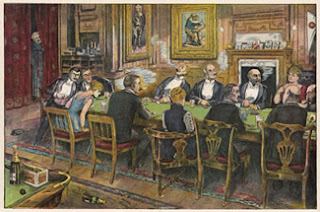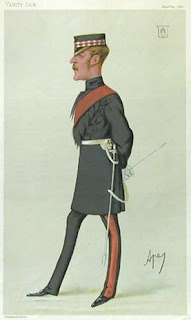While reading about the life of Britain’s King Edward VII, I encountered a scandal that he was involved in prior to his ascension to the throne, while he was still Prince of Wales, in 1890. A close friend of his, Sir William Gordon-Cumming, was caught cheating during a baccarat game at a weekend party held at Tranby Croft, the home and aristocratic seat of titled shipping magnate Arthur Wilson, who (along with his wife) hosted the party.
After having been caught cheating, Gordon-Cumming was forced to sign a confession, agreeing never to play cards again in exchange for the silence of the guests regarding his cheating. When a girlfriend of the Prince of Wales let the story leak, Gordon-Cumming sued several of the witnesses, including His Highness, the Prince. This created a scandal for two reasons: one, baccarat was illegal and the Prince had been dealing and banking the game, and, two, both the Prince of Wales and Gordon-Cumming were officers in the British Army, and, as such, the Prince was legally obligated to report illegal conduct by his fellow officer Gordon-Cumming to their superiors, but had not done so. The whole affair left me with one searing question in my mind: How exactly does one cheat at baccarat?
Turns out that it was stack-capping. In a game where there is absolutely no reason to ever reach over the betting area. And, predictably, everyone noticed. From the Oxford Dictionary of National Biography‘s entry on “Cumming, Sir William Gordon Gordon-, fourth baronet (1848–1930), disgraced socialite”:
Throughout the evening, several players observed Mister William apparently cheating by altering the quantity of the bets he'd up for grabs after he won some loot a hands. Alerted for this, they viewed him more carefully the following evening and confirmed his actions. Sir William won as many as £228 throughout the 2 days of playing.
Incidentally, in spite of obviously having signed a pledge to never play cards again immediately after getting caught, I note that the Oxford Dictionary of National Biography notes that Gordon-Cumming spent much of his forced retirement playing contract bridge. Implying that somebody, somewhere, was willing to play cards with him for money. Crazy things happen.
I was very impressed to discover that a group-portrait photograph existed of all of the people who had been present when Gordon-Cumming was caught cheating. This is a truly remarkable photo. I assume that the photo must have been taken on the evening in question, most or all of the participants probably afterwards being more interested in distancing themselves from the matter than posing for commemorative photographs. Further, the Prince of Wales testified that he had not seen Gordon-Cumming since the incident, and did not “think it agreeable” that he should ever have to encounter the latter again, whereas in the photo, they are noticeably seated together.
(This incidentally begs the question - how many of these big antique group photos that we see and assume to have been family portraits were simply intended to commemorate something as mundane as a card game? Anyhow, the handwritten captioning was almost certainly post-scandal, as there would seem to be no other reason for only Gordon-Cumming and the Prince having their names underlined.)
My initial thought had been that the ladies present in the photo would not have been participants in the game, but I’ve now seen trial testimony that at least two of them personally witnessed him stack-capping (whereas the Prince, dealing, did not). The painting I’ve included at the top of this post has ladies participating in the game, too. I found a wonderful contemporary news account of some of the trial testimony, which the captioned photograph made a nice companion to.
The Prince mentions that at one point during the game, he had to tell Gordon-Cumming to move his hands so that he (acting as banker) could see Gordon-Cumming’s bet. That alone suggests that Gordon-Cumming was acting strangely as far as his hands and chips were concerned. (I am guessing that this game must have been played with chips, or “counters”, given their popularity with the British upper classes at the time, especially fancy ones made from ivory, mother of pearl, or bakelite - cheap chips were made from bone.)
In one of those moments that only happen in movies and on TV, as one of the lawyers was asking the Prince a question, one of the jurors stood up and loudly demanded to know whether the jury was to understand that the Prince, banking and dealing the game, did not notice Gordon-Cumming’s furtive movements. After pausing for a moment to consider whether providing any response would be appropriate, the Prince smiled and admitted that he might have missed a great deal, so unsuspecting he was of the possibility of cheating amongst highbrow friends.
The NYT piece also includes an excellent, and impressively laconic, primer on both baccarat and chemin de fer (and makes it clear that it was the former that was being played at Tranby Croft) - much more brief and digestible than the one that Ian Fleming included in the unabridged version of the novel Casino Royale. Much has been written about the director of the new film’s dodge in that regard - rather than having to explain the game to the audience, just make them play poker. Everyone understands poker. That the entire scene comes off as jaw-droppingly improbable could possibly have been avoided by moving the Monte Carlo-doppelgänger setting and removing the tuxedos. Sure, you’re messing with an awful lot there, but, then, changing the game that the entire plot revolves around is already taking some pretty blatant liberties.
Anyhow, now we know how Gordon-Cumming cheated at baccarat, although whether stack-capping is cheating at cards or simply outright fraud might be worthy of some debate. Although the Prince’s testimony made it clear that the Prince believed it to be decidedly the former, really, Gordon-Cumming didn’t interfere with the game in any way; he simply misrepresented the amounts of money owed to and by him after hands had been played out. But, then, if we follow this to its logical conclusion, only the dealers and the player holding the shoe are actually “playing baccarat”, and the other players are just disinterested observers betting on how the game is gonna go. Unless, of course, they insist on bending and tearing up the cards; then they’re actually playing the game by participating in one of its many pointless rituals.
At this point I am quite certain that I have given Gordon-Cumming far more thought than any dead toff is probably worth. But I’m left with something of a dilemma regarding how to think about him. He’s either a weaselly card cheat and product of a strange subculture that was incredibly big on setting abstract concepts into stone, or remarkably admirable for going down with the ship the way that he did. I mean, here’s the situation: Daisy Brook truthfully babbles that Gordon-Cumming pastposted his bets. Gordon-Cumming responds by suing half a dozen witnesses to his cheating (not just the ones whose signatures were on the document) for defamation, knowing full well that evidence of his guilt existed in his own handwriting. That’s sticking with your story right there.
Epilogue: Gordon-Cumming’s suit was dismissed as being without merit. The next day, he was married to a woman who then assumed the responsibility of paying his bills. Gordon-Cumming referred to her as “the fat little frump” and she never missed an opportunity to remind him that she was the household’s sole source of income (a massive humiliation in the circles in which Gordon-Cumming had once travelled) and that it was she who paid his bills, especially if company was present. The Prince of Wales went on to be King of England and Arthur Wilson died of consumption shortly thereafter. Daisy Brook became known to history by the wonderful epithet, “The Babbling Brook”.


